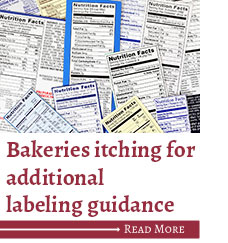Including “Added Sugars” on a label is like putting on bright red lipstick as a final touch to a finished face: It’s supposed to catch the eye.
“On average, Americans get about 13% of their total calories from added sugars, with the major sources being sugar-sweetened beverages and snacks and sweets,” the Food and Drug Administration reported. “It is difficult to meet nutrient needs while staying within calorie requirements if you consume more than 10% of your total daily calories from added sugars. The updates to the label will help increase consumer awareness.”
The F.D.A. defines added sugars as those that are incorporated during the processing of foods or that are simply packaged such as a bag of table sugar or container of syrup. They include monosaccharides, disaccharides, sugars from certain syrups and sugars from concentrated fruit or vegetable juices.
“Any amount of fruit or vegetable juice sugar concentrate that’s going to be in excess of what’s expected in the same volume of 100% juice is an added sugar,” said Melissa Grzybowski, U.S. regulatory and nutrition specialist, Food Consulting Co. “People will use a date paste or a raisin puree, and that doesn’t count as added sugar, but as soon as you use just the fruit juice part of it, then that counts. That piece of it gets a little tricky.”
 The American Bakers Association questions the science behind the inclusion of added sugar on the label, said Lee Sanders, senior vice-president of government relations and public affairs and corporate secretary, A.B.A.
The American Bakers Association questions the science behind the inclusion of added sugar on the label, said Lee Sanders, senior vice-president of government relations and public affairs and corporate secretary, A.B.A.
“There’s not an analytical method to measure for added sugar,” she said. “In the baking process, sugar feeds the yeast, so what you put in is not necessarily reflected in the final product.”
Although the F.D.A. has included a formula for bakers, Ms. Sanders said it is several pages long and too complicated, so it would be helpful for the administration to provide more guidance for measuring purposes.
Ms. Sanders expressed concerns about how the sugar updates as well as the carbohydrates listing will be interpreted by consumers, especially certain demographic groups such as diabetics who need to keep a count of what they’re consuming. She stressed that the most important action might be to educate consumers on how to read the label’s new information, especially regarding “Added Sugars.”
Gunther Brinkman, vice-president, contract manufacturing, Ideal Snacks Corp., suspected that some snacks will suffer from the inclusion of added sugars on the label.
“Even if the amount of sugar in the product does not change, some shoppers will see the additional call-out and make assumptions about the product,” he explained.
On the other hand, added sugars seem to be a big deal for consumers who are looking for transparency, Ms. Grzybowski said, so the label change could be faster and easier for consumers to find what they’re looking for while shopping.




